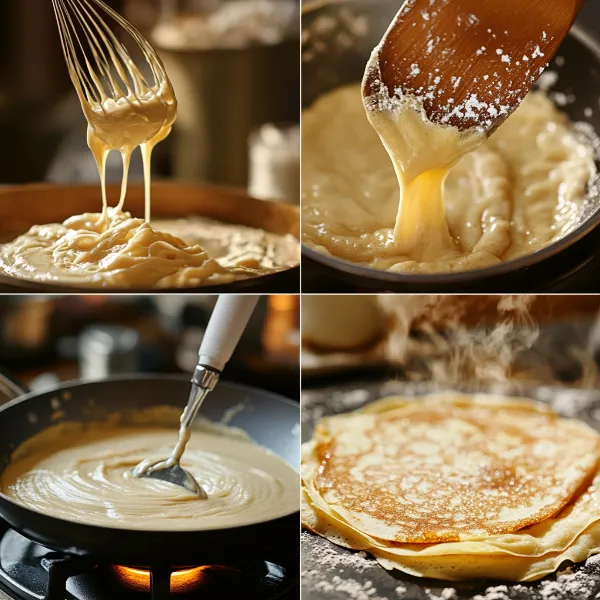Homemade Crepes Recipe is the key to creating a versatile and delicious dish that can be enjoyed any time of the day, whether for breakfast, lunch, or dessert. Thin, light, and endlessly customisable, homemade crepes have captured the hearts of food lovers around the world. This guide explores everything you need to know about making crepes at home, including their history, benefits, and creative variations to inspire your next culinary creation.
What Are Crepes?
Crepes are thin pancakes made from a simple batter of flour, eggs, milk, and butter. Originating in France, crepes are cooked on a flat surface until golden and can be filled with sweet or savoury ingredients.
The History of Crepes: From French Kitchens to Global Fame
- Origins: Crepes were first made in the Brittany region of France, where they became a staple dish due to their simplicity and versatility.
- Global Popularity: Over time, crepes have gained international acclaim, becoming a favourite street food and restaurant offering worldwide.
Pro Tip: The French traditionally enjoy crepes on La Chandeleur (Candlemas), where flipping a crepe in the pan while holding a coin is said to bring good luck.
Why Crepes are Loved for Breakfast, Lunch, and Dessert
Crepes are adored for their ability to suit any meal:
- Breakfast: Sweet crepes with jam, fruit, or Nutella are a morning delight.
- Lunch: Savoury crepes filled with cheese, ham, or spinach make a satisfying mid-day meal.
- Dessert: Crepes paired with chocolate, cream, or caramel are an indulgent treat.
Pro Tip: Crepes can be made ahead of time and reheated, making them perfect for busy schedules or entertaining guests.
Benefits of Making Crepes at Home
Homemade crepes are a cost-effective, customisable option for any occasion.
Fresh, Customisable, and Cost-Effective
- Freshness: Homemade crepes taste better because they’re freshly made with no preservatives.
- Customisation: Tailor your crepes to suit your preferences, whether you prefer sweet or savoury fillings.
- Budget-Friendly: Crepes are made with basic pantry staples, making them an affordable choice for families.
Pro Tip: Experiment with different flours, such as buckwheat or whole wheat, for unique flavour and texture.
Easy to Prepare with Simple Ingredients
- Minimal Tools: All you need is a mixing bowl, whisk, and a non-stick frying pan or crepe maker.
- Quick Cooking: Each crepe takes just a few minutes to cook, making them ideal for quick meals or snacks.
Pro Tip: Use a ladle to pour the batter and swirl it evenly across the pan for perfectly thin crepes.
Types of Crepes: Sweet vs Savoury
One of the joys of crepes is their adaptability to suit sweet and savoury cravings.
Popular Fillings for Sweet Crepes
- Classic Toppings: Sugar and lemon juice, Nutella, or whipped cream with fresh berries.
- Decadent Desserts: Chocolate ganache, caramelised bananas, or a drizzle of salted caramel.
Pro Tip: Dust sweet crepes with icing sugar for an elegant touch.
Creative Ideas for Savoury Crepes
- Cheese and Meat: Fill with Gruyère and ham or a mix of cheddar and bacon beef.
- Vegetarian Options: Try creamed spinach, mushrooms, and goat cheese for a lighter alternative.
- Fusion Flavours: Experiment with fillings like curried vegetables, smoked salmon, or spiced chickpeas.
Pro Tip: Fold savoury crepes into triangles or roll them for easy serving and a polished presentation.

Perfecting Your Homemade Crepes
Mastering the art of homemade crepes goes beyond just cooking them—it’s about customising flavours, exploring creative variations, and serving them in imaginative ways. This guide provides tips, variations, and serving suggestions to elevate your crepe-making skills.
Tips for Success
A few essential tips can make all the difference when preparing crepes.
How to Prevent Crepes from Sticking
- Preheat the Pan: Ensure your pan is evenly heated before adding the batter.
- Lightly Grease: Use a small amount of butter or oil, spread evenly with a brush or paper towel.
- Non-Stick Surface: A non-stick pan or well-seasoned crepe pan is ideal for hassle-free flipping.
Pro Tip: Re-grease the pan lightly between batches to maintain a non-stick surface.
Adjusting Batter Consistency for Desired Thickness
- Thinner Crepes: Add a splash of milk or water to the batter for ultra-thin crepes.
- Thicker Crepes: Add a tablespoon of flour if the batter feels too runny.
Pro Tip: Batter should have the consistency of single cream for perfect crepes.
Creative Variations
Take your crepes to the next level by experimenting with alternative ingredients and flavours.
Gluten-Free or Vegan Crepe Alternatives
- Gluten-Free: Use buckwheat flour, oat flour, or a gluten-free all-purpose mix.
- Vegan: Replace eggs with flaxseed or chia seed mixtures and use almond milk or oat milk instead of dairy milk.
Vegan Crepe Recipe:
- 1 cup (120g) all-purpose flour (or gluten-free flour)
- 1 1/2 cups (375ml) almond milk
- 1 tablespoon flaxseed meal + 2.5 tablespoons water (let sit for 5 minutes)
- 2 tablespoons (30g) melted coconut oil
Pro Tip: Rest vegan or gluten-free batter longer to improve texture.
Adding Cocoa or Spices to the Batter for Unique Flavours
- Cocoa Powder: Add 2 tablespoons of cocoa for chocolate crepes.
- Spices: A pinch of cinnamon, nutmeg, or cardamom can transform the flavour profile.
Pro Tip: Pair spiced crepes with complementary fillings, such as apple compote for cinnamon-flavoured batter.

Serving Suggestions
Crepes are incredibly versatile, making them a perfect base for creative dishes or accompaniments.
Pairing Crepes with Beverages: Coffee, Tea, or Wine
- Coffee: Sweet crepes pair wonderfully with cappuccino or espresso.
- Tea: Green tea complements savoury crepes, while chai works beautifully with spiced versions.
- Wine: A light white wine or sparkling option enhances the flavours of savoury crepes.
Pro Tip: For dessert crepes, serve with a sweet dessert wine or Prosecco.
Crepes as a Base for Creative Dishes (e.g., Crepe Cake)
- Crepe Cake: Layer sweet crepes with whipped cream or ganache, alternating flavours for a stunning dessert.
- Savoury Crepe Rolls: Fill crepes with deli meats, cream cheese, and herbs, then roll and slice for appetisers.
- Breakfast Wraps: Use crepes as a wrap for scrambled eggs, avocado, and cheese.
Pro Tip: Chill crepes before assembling crepe cakes for easier handling.
FAQs About Homemade Crepes
How Long Can Crepe Batter Be Stored?
- Refrigeration: Crepe batter can be stored in the fridge for up to 2 days in an airtight container.
- Mix Before Use: Stir the batter before cooking to redistribute ingredients.
Pro Tip: If the batter thickens in the fridge, add a splash of milk or water to restore consistency.
Can You Freeze Cooked Crepes?
Yes, cooked crepes freeze well for future use:
- How to Freeze: Stack crepes with parchment paper between each layer, then wrap tightly in cling film or place in a freezer bag.
- Storage Time: Frozen crepes can last up to 3 months.
Pro Tip: Thaw crepes in the fridge overnight before reheating.
What’s the Best Way to Reheat Crepes?
- Microwave: Reheat crepes in 10-second intervals until warm.
- Stovetop: Warm in a dry pan over low heat for a minute on each side.
- Oven: Cover crepes with foil and heat at 160°C (325°F) for 5–10 minutes.
Pro Tip: Brush crepes lightly with butter before reheating for added moisture and flavour.
With these tips, variations, and serving ideas, your homemade crepes will be nothing short of perfection. Let me know if you’d like additional inspiration or specific recipes!
